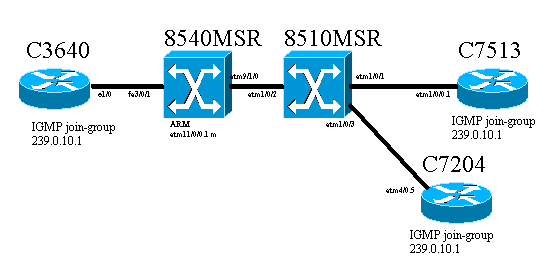Introduction
As networks increase in size, IP multicast routing becomes critically important as a means to determine which segments require multicast traffic and which do not. IP multicast is a routing technique that allows IP traffic to be propagated from one source to a number of destinations, or from many sources to many destinations. Rather than sending one packet to each destination, one packet is sent to the multicast group identified by a single IP destination group address.
This document shows how to configure IP multicast routing over an ATM Router Module (ARM) on a Catalyst 8540 MSR. This configuration is supported on both ARM and enhanced ARM (known as ARM I and ARM II, respectively).
Requirements
Readers of this document should be knowledgeable about basic IP multicasting configurations on Cisco routers. For background information, refer to these documents:
Components Used
The information in this document is based on these software and hardware versions:
- Cisco 3600, 7200, and 7500 series routers running Cisco IOS® Software Release 12.1.(7)
- Catalyst 8540 MSR and Catalyst 8510 MSR running Cisco IOS Software Release 12.1(7)EY
The information in this document was created from the devices in a specific lab environment. All of the devices used in this document started with a cleared (default) configuration. If your network is live, make sure that you understand the potential impact of any command.
Configure
In this section, you are presented with the information to configure the features described in this document.
Network Diagram
This document uses the network setup shown in this diagram:
The Cisco 3640 router, known as C3640, is connected to the Cisco Catalyst 8540 MSR (known as 8540MSR) through the Fast Ethernet port 3/0/1. The 8540MSR has an ARM on slot 11. The C8540MSR is physically connected to the 8510MSR using interface atm 9/1/0. The 8510MSR ATM switch connects to the 8540MSR on ATM interface 1/0/2.
There are two permanent virtual circuits (PVCs) built through the 8510MSR. One is from the 8540MSR ARM multipoint subinterface to the C7513 router and the other is from the same 8540MSR ARM multipoint subinterface to the C7204 router. The routing protocol used is Open Shortest Path First (OSPF). IP Protocol Independent Multicast (PIM) dense-mode is configured on the routers. This includes the ARM module on 8540MSR. C3640, C7513, and C7204 have one interface configured to join the multicast-group 239.0.10.1. A ping from C3640 to the multicast address 239.0.10.1 gets responses from C3640, C7513, and C7204.
Configurations
This section contains the portions of the configuration on the routers and switches described in the network diagram. This is some specific information about the configuration:
- The configuration that appears in this document uses encapsulation aal5mux.
- A multipoint subinterface is created on ARM, while ATM PVCs are configured to the remote sites.
- PIM is used in dense-mode. As far as PIM is concerned, ARM does not differentiate between individual VCs on the multipoint interface.
- Multicast traffic is forwarded out to all VCs that have "broadcast" configured.
- The show ip mroute output illustrates that PIM only identifies the outgoing interface and not individual VCs.
The configuration for IP multicast routing with the help of PIM is shown here. All the relevant commands for IP multicast routing are shown in bold.
C3640
ip multicast-routing
!
interface Ethernet1/0
ip address 10.10.200.1 255.255.255.0
ip pim dense-mode
ip igmp join-group 239.0.10.1
half-duplex
!
!
router ospf 1
log-adjacency-changes
network 10.10.200.0 0.0.0.255 area 0
!
C850MSR
ip multicast-routing ! interface FastEthernet3/0/1 ip address 10.10.200.2 255.255.255.0 ip pim dense-mode no ip route-cache no ip mroute-cache ! ! interface ATM11/0/0.1 multipoint ip address 75.75.75.2 255.255.255.0 ip pim dense-mode ip ospf network point-to-multipoint map-group multicast atm pvc 2 1000 pd on encap aal5mux ip interface ATM9/1/0 0 1000 atm pvc 2 1001 pd on encap aal5mux ip interface ATM9/1/0 0 1001 ! ! router ospf 1 log-adjacency-changes network 10.10.200.0 0.0.0.255 area 0 network 75.75.75.0 0.0.0.255 area 0 ! map-list multicast ip 75.75.75.1 atm-vc 1000 aal5mux broadcast ip 75.75.75.3 atm-vc 1001 aal5mux broadcast8510MSRinterface ATM1/0/2 no ip address atm pvc 0 1000 interface ATM1/0/1 0 1000 ! interface ATM1/0/3 no ip address atm pvc 0 1001 interface ATM1/0/2 0 1001 !C7513ip multicast-routing ! ! interface Ethernet9/0/2 ip address 30.30.30.1 255.255.255.0 ip pim dense-mode ip igmp join-group 239.0.10.1 ! interface ATM1/0/0.1 multipoint ip address 75.75.75.1 255.255.255.0 ip pim dense-mode no ip route-cache ip ospf network point-to-multipoint no ip mroute-cache map-group multicast atm pvc 1000 0 1000 aal5mux ip ! ! router ospf 1 log-adjacency-changes network 30.30.30.0 0.0.0.255 area 0 network 75.75.75.0 0.0.0.255 area 0 ! map-list multicast ip 75.75.75.2 atm-vc 1000 broadcast!C7204ip multicast-routing ! interface Loopback0 ip address 40.40.40.1 255.255.255.0 ip igmp join-group 239.0.10.1 ! ! interface ATM4/0.5 multipoint ip address 75.75.75.3 255.255.255.0 ip pim dense-mode no ip route-cache ip ospf network point-to-multipoint no ip mroute-cache map-group multicast atm pvc 1 0 1001 aal5mux ip ! router ospf 1 log-adjacency-changes network 40.40.40.0 0.0.0.255 area 0 network 75.75.75.0 0.0.0.255 area 0 ! map-list multicastip 75.75.75.2 atm-vc 1 broadcastVerify
Use these commands to test that your network operates properly:This allows you to view an analysis of showcommand output.
Therefore, we have completed our lab session on Configuring IP Multicast Routing over ATM Route Module (ARM).





No comments:
Post a Comment